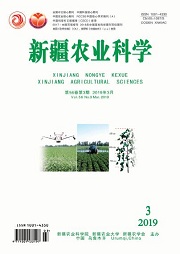|
|
Effects of Different Exogenous Substances on Biomass, Yield and Quality of Chemically Capped Cotton
Alimujiang Kelaimu, ZHAO Qiang, ZHAN Dong-xia, Nuermanguli Batuer, CUI Yan-nan, LOU Shan-wei
2019, 56(3):
411-421.
DOI: 10.6048/j.issn.1001-4330.2019.03.003
Objective The effects of spraying different exogenous substances on chlorophyll content, biomass accumulation, yield formation and fiber quality of chemically capped cotton were studied by field experiments in order to provide a theoretical basis for optimizing chemical capping technology and promoting high quality cotton production. Methods The cotton variety Xinluzao 72 was used as the test material. During the full bloom period (July 17th), 8 different exogenous substances were sprayed: T1, 0.4 mmol/L 6-BA; T2, 35 mmol/L octanoic acid. Methyl ester; T3, 30 g/hm2 acid-regulating calcium; T4, 35 mmol/L methyl citrate; T5, 0.24 mmol/L sodium nitrophenolate; T6, 0.056 mmol/L DA-6; T7, 0.096 mmol/L NAA; T8, 0.01 mmol/L triacontanol; CK, clear water. The dry matter weight of each representative cotton plant was measured at 0 d, 14 d, 28 d and 42 d after spraying. The effect of chlorophyll content on the four leaves of cotton was determined at 0 d, 7 d, 14 d, 21 d after spraying Results The results showed that 8 kinds of exogenous substances had certain effects on improving cotton chlorophyll content, biomass, yield and quality. Methyl octanoate (T2), sodium naphthalene acetate (T7) and sodium nitrophenolate (T5) were adjusted. Calcium acid (T3) could increase chlorophyll content, increase biomass accumulation, increase seed cotton yield, and improve quality. Among them, methyl octanoate (T2) and CK could significantly increase chlorophyll content by more than 10%, which was beneficial to biomass accumulation and distribution. The number of bolls per plant was increased by 9.15% and the yield of seed cotton was increased by 25.50%. The overall effect of increasing fiber length, uniformity, specific strength and elongation was the best. Conclusions Spraying different exogenous substances on the foliage during the full bloom period can effectively increase the chlorophyll content, the number of bolls, increase the boll weight and the length of the fiber, and the growth effect is obvious. Methyl octanoate can significantly increase chlorophyll content, dry matter accumulation and distribution, and increase single boll weight and seed cotton yield, followed by sodium naphthaleneacetate, sodium nitrophenolate, calcium cyclamate, and 6-BA.
|

